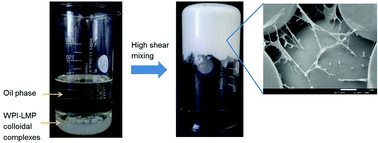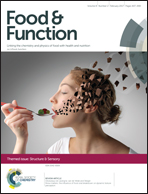High internal phase emulsions stabilized solely by whey protein isolate-low methoxyl pectin complexes: effect of pH and polymer concentration†
Abstract
In recent years, there has been significant progress in edible emulsion technology especially with respect to creating and stabilizing surfactant-free emulsion systems for food applications. In this paper, we demonstrate the fabrication of high internal phase emulsions (HIPE) (φoil = 0.82) stabilized using colloidal complexes of non-gelling biopolymers (at concentrations as low as 0.3 wt%). The colloidal complexes were pre-formed by combining whey protein isolate (WPI) and low-methoxyl pectin (LMP) at three different pH values (i.e. pH 3.5, 4.5, 5.5) and used further for fabricating stable HIPEs. In addition to the effect of pH, the influence of total biopolymer concentration on the formation and properties of HIPEs was also evaluated. Depending on the total concentration of biopolymers used, the WPI–LMP complexes (formed at pH 4.5) showed a Z-average diameter in the range of 250–350 nm. It was found that the formation of HIPEs was strongly influenced by the pH of the colloidal complexes. At a pH close to the isoelectric point of WPI (≈pH 4.8) and WPI–LMP complexes (≈pH 3.4), severe aggregation of colloidal particles occurred, resulting in poor formation and stability of HIPEs. On comparing the stabilization behaviour of the complexes with the uncomplexed protein, it was noticed that the former provided comparatively better stabilization to the HIPEs against coalescence at pH 4.5 and 5.5. Based on the rheological data (low amplitude oscillatory shear rheology and flow measurements), all HIPE samples showed viscoelastic and shear-thinning behaviour. We believe that such viscoelastic gel-like systems could find potential commercial applications in the development of label-friendly novel food products with interesting textures.

- This article is part of the themed collection: Structure & Sensory


 Please wait while we load your content...
Please wait while we load your content...